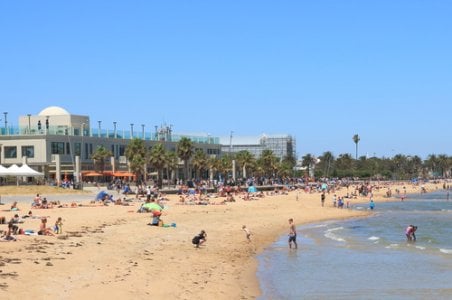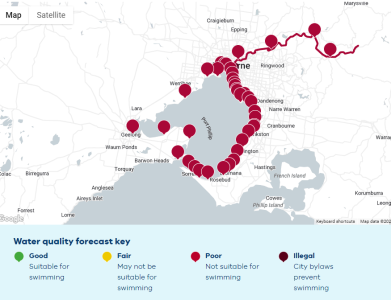Discover the shocking reason behind the closure of over 30 beaches—is your favourite spot on the list?
The allure of Australia's beaches is undeniable, with their golden sands and inviting waves making them a favourite for locals and tourists alike.
However, recent events have cast a shadow over this idyllic image, particularly in Victoria, where more than 30 beaches have been declared no-go zones for swimmers due to severe contamination.
The Environmental Protection Agency (EPA) has sounded the alarm, issuing a warning to beachgoers to steer clear of the affected areas.
The cause of this unsettling situation? A cocktail of pollutants, including debris, oil, and faeces, has rendered the waters of Port Phillip Bay unsafe for public recreation.

The EPA's assessment of the water quality in Victoria's Port Phillip Bay has resulted in a 'poor' rating, a concerning indicator that not a single beach in the bay is considered safe for swimming.
The impact stretches from Portsea to Mentone and extends to Altona, with 36 beaches now bearing the unfortunate 'unsafe' label.
Mark Taylor, the EPA's Chief Environmental Scientist, explained that the bay's water quality often deteriorates following significant weather events.
'With heavy rains, everything gets flushed into the river—vehicles, faeces—it all gets into the water system and out into the ocean,' Mr Taylor explained.
The implication is clear: the contaminants pose a serious health risk, and exposure to such pollution could have dire consequences.

The presence of oil and debris, including pieces of wood, amidst the pollutants, adds to the stomach-churning reality facing Victoria's beaches.
This environmental crisis follows a period of heavy rain in the state, which saw a month's worth of precipitation pour down in a single day.
Record-breaking rainfall totals, some surpassing 150-year records, have overwhelmed the region, leading to widespread damage and emergency calls.
The deluge has not only affected the water quality but also the safety of residents.
In a harrowing incident, a woman nearly drowned after being swept into a stormwater drain, her cries for help drowned out by the torrential rain. The woman managed to latch onto a metal pole and screamed for help, but nobody could hear her.
After what must have felt like an eternity battling the rushing water, she used the pole to pull herself to safety.
We understand the importance of staying informed about environmental and safety concerns, especially when it involves our cherished coastal areas. For those who love the beach, this news is undoubtedly disappointing.
However, it's crucial to heed the warnings issued by authorities and avoid the affected beaches until they are declared safe once more.
The health risks associated with contaminated water cannot be understated, and it's better to err on the side of caution.
 Are you affected by the beach closures in Victoria? Let us know in the comments below!
Are you affected by the beach closures in Victoria? Let us know in the comments below!
However, recent events have cast a shadow over this idyllic image, particularly in Victoria, where more than 30 beaches have been declared no-go zones for swimmers due to severe contamination.
The Environmental Protection Agency (EPA) has sounded the alarm, issuing a warning to beachgoers to steer clear of the affected areas.
The cause of this unsettling situation? A cocktail of pollutants, including debris, oil, and faeces, has rendered the waters of Port Phillip Bay unsafe for public recreation.

More than 30 beaches in Victoria have ‘poor’ water quality, according to EPA. Image source: Shutterstock
The EPA's assessment of the water quality in Victoria's Port Phillip Bay has resulted in a 'poor' rating, a concerning indicator that not a single beach in the bay is considered safe for swimming.
The impact stretches from Portsea to Mentone and extends to Altona, with 36 beaches now bearing the unfortunate 'unsafe' label.
Mark Taylor, the EPA's Chief Environmental Scientist, explained that the bay's water quality often deteriorates following significant weather events.
'With heavy rains, everything gets flushed into the river—vehicles, faeces—it all gets into the water system and out into the ocean,' Mr Taylor explained.
The implication is clear: the contaminants pose a serious health risk, and exposure to such pollution could have dire consequences.

The EPA has deemed 36 beaches in Port Phillip unsafe. Image source: Environmental Protection Agency Victoria
The presence of oil and debris, including pieces of wood, amidst the pollutants, adds to the stomach-churning reality facing Victoria's beaches.
This environmental crisis follows a period of heavy rain in the state, which saw a month's worth of precipitation pour down in a single day.
Record-breaking rainfall totals, some surpassing 150-year records, have overwhelmed the region, leading to widespread damage and emergency calls.
The deluge has not only affected the water quality but also the safety of residents.
In a harrowing incident, a woman nearly drowned after being swept into a stormwater drain, her cries for help drowned out by the torrential rain. The woman managed to latch onto a metal pole and screamed for help, but nobody could hear her.
After what must have felt like an eternity battling the rushing water, she used the pole to pull herself to safety.
We understand the importance of staying informed about environmental and safety concerns, especially when it involves our cherished coastal areas. For those who love the beach, this news is undoubtedly disappointing.
However, it's crucial to heed the warnings issued by authorities and avoid the affected beaches until they are declared safe once more.
The health risks associated with contaminated water cannot be understated, and it's better to err on the side of caution.
Key Takeaways
- Over 30 beaches in Victoria have been ruled unsafe due to contamination following heavy rainfall.
- Contaminants such as debris, oil, and faeces have been found in the water, leading to poor quality ratings.
- The Environmental Protection Agency has issued a health-based warning, advising the public to avoid swimming in these areas.
- The contaminated water results from pollutants being flushed into the river system after the state experienced significant rain, including a record-breaking downpour.







